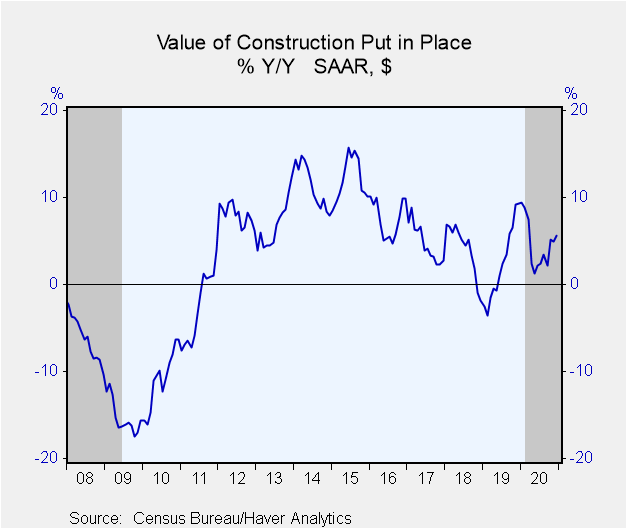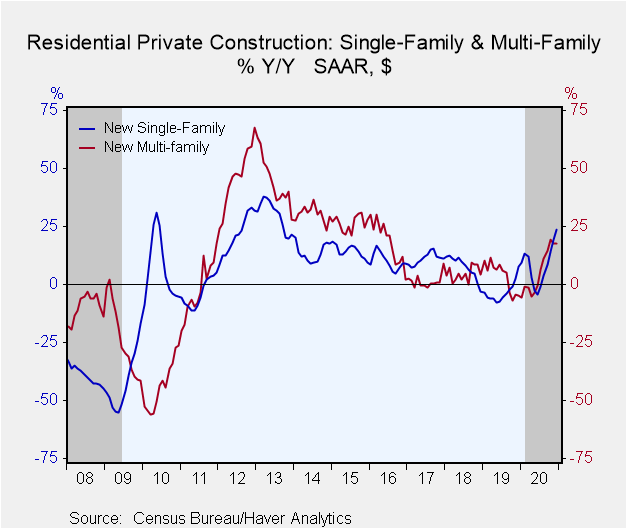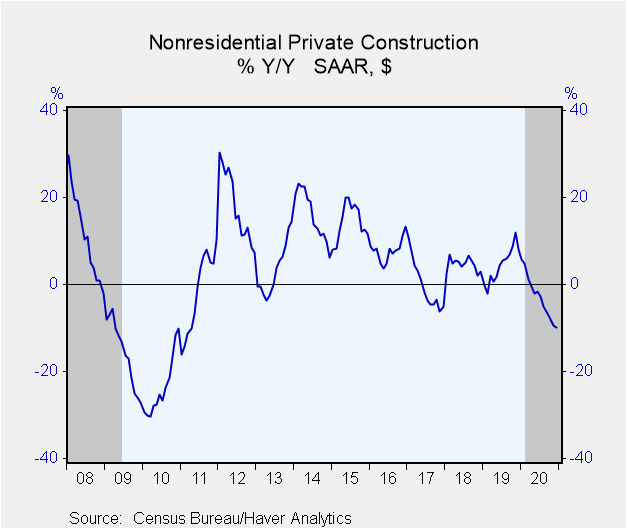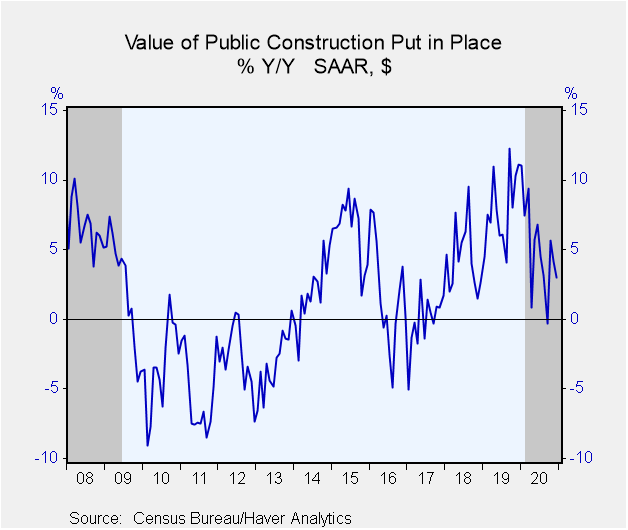 Global| Feb 01 2021
Global| Feb 01 2021U.S. Construction Spending Continues to Improve During December
by:Tom Moeller
|in:Economy in Brief
Summary
• Overall activity hits record high. • Residential building surge led by single-family sector. • Public sector building edges higher. The value of construction put-in-place increased 1.0% during December (5.7% y/y) following [...]
• Overall activity hits record high.
• Residential building surge led by single-family sector.
• Public sector building edges higher.
The value of construction put-in-place increased 1.0% during December (5.7% y/y) following November's 1.1% gain, revised from 0.9%. October's increase was revised to 2.5% from 1.6%. A 0.8% December increase had been expected in the Action Economics Forecast Survey. During all of 2020, construction activity rose 4.7% versus a 2.4% gain in 2019.
Private construction increased 1.2% (6.5% y/y) in December following a 1.5% November increase. Residential construction jumped 3.1% (20.7% y/y) as single-family building surged 5.8% (23.5% y/y), the sixth consecutive month of notably strong increase. The value of multi-family construction was little changed (17.8% y/y) for the second month. Home improvement expenditures edged 0.4% higher (17.7% y/y) after little change during November.
Weakness in business spending continued as nonresidential private construction fell 1.7% in December (-9.8% y/y), the sixth consecutive monthly decline. Lodging construction declined 6.4% (-24.6% y/y) while commercial building weakened 2.8% (-1.4% y/y). Manufacturing construction fell 5.6% (-17.6% y/y) while education construction eased 0.8% (-15.3% y/y). To the upside, transportation building rose 2.2% (-1.6% y/), strong for the fourth straight month. Office building improved 0.2% (-3.3% y/y) about as it did in November.
Public construction rose 0.5% during December (3.0% y/y) following a 0.1% November slip. Spending on highways & streets, which makes up nearly one-third of public spending, rose 0.9% (3.9% y/y) and outlays on health care units improved 0.4% (4.7% y/y). Power construction eased 0.5% (-15.2% y/y) while spending on educational buildings gained 0.6% (4.5% y/y).
The construction spending figures, some of which date back to 1946 can be found in Haver's USECON database. The expectations reading is in the AS1REPNA database.
| Construction Put in Place (SA, %) | Dec | Nov | Oct | Dec Y/Y | 2020 | 2019 | 2018 |
|---|---|---|---|---|---|---|---|
| Total | 1.0 | 1.1 | 2.5 | 5.7 | 4.7 | 2.4 | 4.2 |
| Private | 1.2 | 1.5 | 2.4 | 6.5 | 4.7 | 0.8 | 4.0 |
| Residential | 3.1 | 3.0 | 4.8 | 20.7 | 11.6 | -2.4 | 3.4 |
| Nonresidential | -1.7 | -0.6 | -0.7 | -9.8 | -3.0 | 4.5 | 4.8 |
| Public | 0.5 | -0.1 | 2.6 | 3.0 | 4.8 | 7.8 | 4.6 |
Tom Moeller
AuthorMore in Author Profile »Prior to joining Haver Analytics in 2000, Mr. Moeller worked as the Economist at Chancellor Capital Management from 1985 to 1999. There, he developed comprehensive economic forecasts and interpreted economic data for equity and fixed income portfolio managers. Also at Chancellor, Mr. Moeller worked as an equity analyst and was responsible for researching and rating companies in the economically sensitive automobile and housing industries for investment in Chancellor’s equity portfolio. Prior to joining Chancellor, Mr. Moeller was an Economist at Citibank from 1979 to 1984. He also analyzed pricing behavior in the metals industry for the Council on Wage and Price Stability in Washington, D.C. In 1999, Mr. Moeller received the award for most accurate forecast from the Forecasters' Club of New York. From 1990 to 1992 he was President of the New York Association for Business Economists. Mr. Moeller earned an M.B.A. in Finance from Fordham University, where he graduated in 1987. He holds a Bachelor of Arts in Economics from George Washington University.










